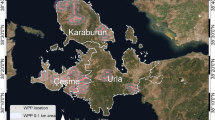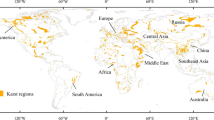Abstract
The study presents a GIS- and RS-based diagnostic model to determine the changes in the existing vegetation in the Urla, Çeşme, and Karaburun peninsulas, Turkey, between 2002 and 2017 after the installation of 239 wind power plants (WPP). The vegetation changes in 7 CORINE land cover classes within the 0–1 km (facility zone) and 1–2 km (control zone) buffer zones were detected in relation with the slope and aspect groups using NDVI analysis. The highest amount of negative change in broad-leaved forests, coniferous forests, and land principally occupied by agriculture, with significant areas of natural vegetation, was detected in the 3–5% slope group, while pasture lands, sclerophyllous vegetation and transitional woodland-shrubs showed the highest degradation in 1–2% slope areas. Negative changes in complex cultivation patterns were found to be on the flat surfaces. Except for the pasture lands and sclerophyllous vegetation classes, the highest degradations were observed on north-facing aspects. In all land cover classes, the most degraded areas were found to be within the facility zone. The results and the proposed model are expected to facilitate planning and decision-making processes for locations with similar landscape characteristics.
Graphical abstract






Similar content being viewed by others
Availability of data and materials
The data sets used and/or analyzed during the current study are available from the corresponding author on reasonable request.
References
Akkoyunlu A (2006) Energy Resources and Environmental Impacts in Turkey. In: Energy and development symposium in Turkey, p 26
Aksoy T (2021) Diagnostic approach to determining the effects of windturbines on vegetation by geomatic technologies: Sampling ofUrla, Çeşme, Karaburun peninsula. Doctoral Thesis. Eskisehir: Graduate School of Education. Eskisehir Technical University. Ph.D Thesis, Eskisehir, Turkey.
ASTER (2020) Jet Propulsion Laboratory, California Institute of Technology, Digital Elevation Model (DEM) created from ASTER image. https://asterweb.jpl.nasa.gov/gdem.asp (access on 03.12.2020)
Baidya Roy S, Pacala SW, Walko RL (2004) Can large wind farms affect local meteorology? J Geophys Res Atmos 109(D19):91–101. https://doi.org/10.1029/2004JD004763
Braunisch V, Coppes J, Bächle S, Suchant R (2015) Underpinning the precautionary principle with evidence: A spatial concept for guiding wind power development in endangered species’ habitats. J Nat Conserv 24:31–40
Chang R, Zhu R, Guo P (2016) A case study of land-surface-temperature impact from large-scale deployment of wind farms in China from Guazhou. Remote Sens 8(10):790
Dai K, Bergot A, Liang C, Xiang WN, Huang Z (2015) Environmental issues associated with wind energy–a review. Renew Energy 75:911–921
Desholm M, Kahlert J (2005) Avian collision risk at an offshore windfarm. Biol Let 1:296–298
Diaz-Cuevas P, Dominguez-Bravo J, Prieto-Campos A (2019) Integrating MCDM and GIS for renewable energy spatial models: assessing the individual and combined potential for wind, solar and biomass energy in Southern Spain. Clean Technol Environ Policy 21:1855–1869. https://doi.org/10.1007/s10098-019-01754-5
Drewitt AL, Langston RHW (2006) Assessing the impacts of wind farms on birds. Ibis 148:29–42
Drewitt AL, Langston RH (2008) Collision effects of wind-power generators and other obstacles on birds. Ann N Y Acad Sci 1134(1):233–266. https://doi.org/10.1196/annals.1439.015
Erdem Ü, Nurlu E, Yilmaz O, Veryeri NO (2002) Natural structure analysis and agricultural areas: a case study of Karaburun Peninsula, Turkey. Coastal zone management in the Mediterranean region, pp 155–160
Erickson WP, Johnson GD, Young D, Strickland MD, Good R, Bourassa M, Bay K, Sernka K (2002) Synthesis and comparison of baseline avian and bat use, raptor nesting and mortality information from proposed and existing wind developments. Report prepared for Bonne-ville Power Administration, pp 1–60
Fagúndez J (2008) Effects of wind farm construction and operation on mire and wet heath vegetation in the Monte Maior SCI, north-west Spain. Mires Peat 4. http://pixelrauschen.de/wbmp/media/map04/map_04_02.pdf. Accessed on 12 Jan 2022
Fang J, Peringer A, Stupariu MS, Pǎtru-Stupariu I, Buttler A, Golay F, Porté-Agel F (2018) Shifts in wind energy potential following land-use driven vegetation dynamics in complex terrain. Sci Total Environ 639:374–384
Farfan MA, Vargas JM, Duarte J, Real R (2009) What is the impact of wind farms on birds? A case study in southern Spain. Biodivers Conserv 18:3743–3758. https://doi.org/10.1007/s10531-009-9677-4
Fraga MI, Romero-Pedreira D, Souto M, Castro D, Sahuquillo E (2008) Assessing the impact of wind farms on the plant diversity of blanket bogs in the Xistral Mountains (NW Spain). Mires Peat 4(6):1-10. https://www.cabi.org/isc/FullTextPDF/2010/20103292085.pdf. Accessed on 12 Jan 2022
Fernandez RD, Mantz RJ, Battaiotto PE (2007) Impact of wind farms on a power system. Eigenvalue Anal Approach Renew Energy 32(10):1676–1688. https://doi.org/10.1016/j.renene.2006.07.009
FAO (2020) Food and Agriculture Organization of the United Nations. Land and Water. Land Assessment and Impacts. http-2: http://www.fao.org/land-water/land/land-assessment/en/ (Retrieved: 22.05.2020)
Gao Z, Tang C, Zhou X, Ma Y, Wu Y, Yin J, Xu X (2016) An overview on development of wind power generation. In: Chinese control and decision conference (CCDC), pp 435–439. https://doi.org/10.1109/CCDC.2016.7531024
Guo X, Zhang X, Du S, Li C, Siu YL, Rong Y, Yang H (2020) The impact of onshore wind power projects on ecological corridors and landscape connectivity in Shanxi China. J Clean Prod 254:120075
Harding G, Harding P, Wilkins A (2008) Wind turbines, flicker, and photosensitive epilepsy: Characterizing the flashing that may precipitate seizures and optimizing guidelines to prevent them. Epilepsia 49(6):1095–1098
Harris RA, Zhou L, Xia G (2014) Satellite observations of wind farm impacts on nocturnal land surface temperature in Iowa. Remote Sens 6(12):12234–12246
Hoover SI, Morrison ML (2005) Behavior of red-tailed hawks in wind turbine development. J Wildl Manag 69:150–159
Huskey A (2011) Wind Turbine Generator System Acoustic Noise Test Report for the Gaia Wund 11-kW Wind Turbine. Technical Report. USA: NREL
Johnson GD, Erickson WP, Strickland MD, Shepard MF, Shepard DA (2003) Mortality of bats at a large-scale wind power development at Buffalo Ridge, Minnesota. Am Midl Nat 150:332–342
Kumar A, Pal D, Kar SK, Mishra SK, Bansal R (2022) An overview of wind energy development and policy initiatives in India. Clean Technol Environ Policy 24:1337–1358. https://doi.org/10.1007/s10098-021-02248-z
Kuvlesky WP Jr, Brennan LA, Morrison ML, Boydston KK, Ballard BM, Bryant FC (2007) Wind energy development and wildlife conservation: challenges and opportunities. J Wildl Manage 71(8):2487–2498
Krohn S, Damborg S (1999) On public attitudes towards wind power. Renew Energy 16(1–4):954–960
LANDSAT (2020) Landsat Science. Satellite Image Landsat 5 (2000–2011) July and August every year and Satellite Image Landsat 8 (2011–2018) July and August every year. https://landsat.gsfc.nasa.gov/ (access on 03.12.2020)
Leung DY, Yang Y (2012) Wind energy development and its environmental impact: a review. Renew Sustain Energy Rev 16(1):1031–1039
Li G, Zhang C, Zhang L, Zhang M (2016) Wind farm effect on grassland vegetation due to its influence on the range, intensity and variation of wind direction. IEEE Int Geosci Remote Sens pp 1304–1306
Metin TC (2017) Searching for methods in recreation opportunity distribution and planning: The case of Karaburun peninsula. Doctoral Thesis. Eskişehir: Anadolu University, Institute of Social Sciences, Eskisehir, Turkey
Morawitz DF, Blewett TM, Cohen A, Alberti M (2006) Using NDVI to assess vegetative land cover change in central Puget Sound. Environ Monit Assess 114(1):85–106
Official Newspaper (2020) Official Newspaper, 20.10.2015 Tuesday, No: 29508, Regulation on the technical evaluation of applications for wind resource electricity generation. https://resmigazete.gov.tr/eskiler/2015/10/20151020-2.htm (access on 03.12.2020)
Pantazopoulou G (2009) Wind turbine noise measurements and abatement methods. Wind power generation and wind turbine design, pp 641–660.
Pedersen E, Persson Waye K (2004) Perception and annoyance due to wind turbine noise—a dose-response relationship. J Acoust Soc Am 116(6):3460–3470
Pyakurel M, Nawandar K, Ramadesigan V, Bandyopadhyay S (2021) Capacity expansion of power plants using dynamic energy analysis. Clean Technol Environ Policy 23:669–683. https://doi.org/10.1007/s10098-020-01995-9
Ramos-Bernal R, Vázquez-Jiménez R, Romero-Calcerrada R, Arrogante-Funes P, Novillo C (2018) Evaluation of unsupervised change detection methods applied to landslide inventory mapping using ASTER imagery. Remote Sens 10(12):1987
Shen G, Xu B, Jin Y, Chen S, Zhang W, Guo J, Liu H, Zhang Y, Yang X (2017) Monitoring wind farms occupying grasslands based on remote-sensing data from China’s GF-2 HD satellite—A case study of Jiuquan city, Gansu province, China. Resour Conserv Recycl 121:128–136
Sims S, Dent P, Oskrochi R (2008) Modelling the impact of wind farms on house prices in the UK. Int J Strateg Prop Manag 12:251–269. https://doi.org/10.3846/1648-715X.2008.12.251-269
Slawsky LM, Zhou L, Roy SB, Xia G, Vuille M, Harris RA (2015) Observed thermal impacts of wind farms over northern Illinois. Sensors 15(7):14981–15005
Smith, E. R., and Klick, H. (2007). Explaining NIMBY Opposition to Wind Power. American Political Science Association, (pp. 1–19). Boston, Massachusetts. Retrieved from http://docs.wind-watch.org/Smith-Klick-nimby.pdf
Sovacool BK (2013) The avian benefits of wind energy: a 2009 update. Renew Energy 49:19–24. https://doi.org/10.10167/j.renene.2012.01.074
Sun CS, Wang YN, Li XR, Ma SY (2008) Environmental impact of wind power generation projects. J Electr Eng Technol 23:19–23
Tang B, Wu D, Zhao X, Zhou T, Zhao W, Wei H (2017) The observed impacts of wind farms on local vegetation growth in northern China. Remote Sens 9(4):332
Torres Sibille AC, Cloquell-Ballester V-A, Cloquell-Ballester V-A, Darton R (2009) Development and validation of a multicriteria indicator for the assessment of objective aesthetic impact of wind farms. Renew Sustain Energy Rev 13:40–66. https://doi.org/10.10167/j.rser.2007.05.002
Turkish Wind Energy Association (2020). Turkish Wind Energy Association (TWEA) https://tureb.com.tr/ (access on: 03.12.2020)
Xia G, Zhou L (2017) Detecting wind farm impacts on local vegetation growth in Texas and Illinois using MODIS vegetation greenness measurements. Remote Sens 9(7):698
Xu K, He L, Hu H, Liu S, Du Y, Wang Z, Wang G (2019) Positive ecological effects of wind farms on vegetation in China’s Gobi desert. Sci Rep 9(1):1–11
Xu D, Guo X, Li Z, Yang X, Yin H (2014) Measuring the dead component of mixed grassland with Landsat imagery. Remote Sens Environ 142:33–43
Walsh-Thomas JM, Cervone G, Agouris P, Manca G (2012) Further evidence of impacts of large-scale wind farms on land surface temperature. Renew Sustain Energy Rev 16(8):6432–6437
Wang S, Wang S (2015) Impacts of wind energy on environment: a review. Renew Sustain Energy 49:437–443. https://doi.org/10.1016/j.rser.2015.04.137
Wang S, Wang S, Smith P (2015) Ecological impacts of wind farms on birds: questions, hypotheses, and research needs. Renew Sustain Energy Rev 44:599–607. https://doi.org/10.1016/j.rser.2015.01.031
WET (2018) Wind Energy in Turkey. HTTP-1: http://ekolojist.net/turkiyede-ruzgar-enerjisi/ (Retrieved:10.12.2018)
Wiser R, Lantz E, Mai T, Zayas J, DeMeo E, Eugeni E, Tusing R (2015) Wind vision: a new era for wind power in the United States. Electr J 28(9):120–132. https://doi.org/10.1016/j.tej.2015.09.016
Van den Berg GP (2004) Effects of the wind profile at night on wind turbine sound. J Sound Vib 277(4–5):955–970
Yuan D, Elvidge C (1998) NALC land cover change detection pilot study: Washington DC area experiments. Remote Sens Environ 66(2):166–178
Zhou L, Tian Y, Roy SB, Thorncroft C, Bosart LF, Hu Y (2012) Impacts of wind farms on land surface temperature. Nat Clim Chang 2(7):539–543
Acknowledgements
This study was produced from the PhD study supported within the scope of Eskisehir Technical University Scientific Research Projects Project Number 20DRP051
Funding
This study was produced from the PhD study supported within the scope of Eskisehir Technical University Scientific Research Projects project number 20DRP051.
Author information
Authors and Affiliations
Contributions
TA designed the study and performed the experiments; TA, GBO, AC, SNC, MASK and MC performed the experiments, analyzed the data, and wrote the manuscript.
Corresponding author
Ethics declarations
Conflict of interest
All authors certify that they have no affiliations with or involvement in any organization or entity with any financial interest or non-financial interest in the subject matter or materials discussed in this manuscript.
Additional information
Publisher's Note
Springer Nature remains neutral with regard to jurisdictional claims in published maps and institutional affiliations.
Rights and permissions
Springer Nature or its licensor holds exclusive rights to this article under a publishing agreement with the author(s) or other rightsholder(s); author self-archiving of the accepted manuscript version of this article is solely governed by the terms of such publishing agreement and applicable law.
About this article
Cite this article
Aksoy, T., Cetin, M., Cabuk, S.N. et al. Impacts of wind turbines on vegetation and soil cover: a case study of Urla, Cesme, and Karaburun Peninsulas, Turkey. Clean Techn Environ Policy 25, 51–68 (2023). https://doi.org/10.1007/s10098-022-02387-x
Received:
Accepted:
Published:
Issue Date:
DOI: https://doi.org/10.1007/s10098-022-02387-x




